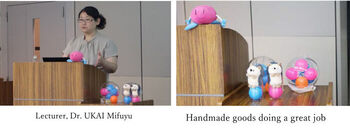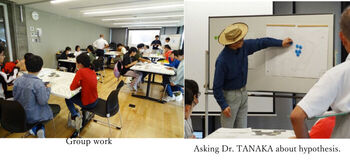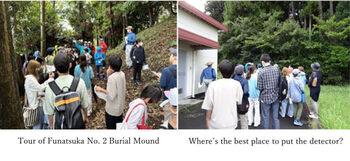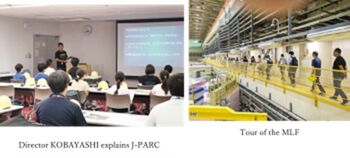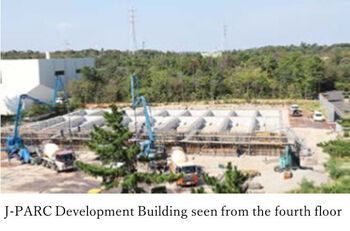J-PARC News September 2024 (Issue #233)
■Report on the observation of a scorched component in the J-PARC Linac Building
We deeply apologize for the concern and inconvenience caused to many people by the observation of a scorched mark on an electrical component in the J-PARC Linac Building on July 5th , 2024.
The J-PARC Center summarized the cause of the incident, countermeasures, and J-PARC wide safety confirmation as a report.
Report on the observation of a scorched component in the J-PARC Linac Building (in Japanese)
https://j-parc.jp/c/information/2024/09/26001394.html
Takashi Kobayashi, Director of J-PARC Center
■Elucidation of Ion Conduction Mechanism of Fluoride Ion-Conductive Solid Electrolytes with Disordered Atomic Arrangement
〜Aiming to create next-generation storage batteries that outperform lithium-ion batteries~( September 6th )
In order to analyze the mechanism of calcium fluoride and barium fluoride ion conduction with fluorite-type structure, Ca0.48 Ba F0.522 solid electrolytes were prepared by using thermal plasma. The atomic arrangement and nuclear density distribution of this system were precisely determined by neutron diffraction of this electrolyte using the special environment neutron diffractometer "SPICA" at the Materials and Life Science Experimental Facility (MLF) of J-PARC. It was then found that the mixing of Ca and Ba, which have different ionic radii, induces structural distortion, and locally disturbs the atomic arrangement of F. Furthermore, the fluoride ionic conduction pathway was visualized to clarify that the disorder of the F atomic arrangement significantly contributes to the enhancement of ionic conductivity in the conduction pathway.
Elucidation of the ionic conduction mechanism in this system will provide a better understanding of the ionic flow in fluoride ionic conductors.
■Hello Science
“Have you heard of Hadrons?" (August 30th)
Dr. UKAI Mifuyu of the Particle and Nuclear Physics Division gave a talk on the relationship between hadrons and the strong force and the prospects for research at J-PARC.
Quarks, the smallest unit of matter, cannot exist on their own, so they exist as hadrons, which are groups of quarks. Protons and neutrons, which we are all familiar with, are hadrons. Hadrons are kept at an exquisite distance from each other by the forces of attraction and repulsion, so that they are neither too attracted to each other to be crushed, nor too far apart to be torn apart, thus making up this universe.
At J-PARC, researchers use high-intensity and high-purity beams of negatively charged K mesons (K-) to create nuclei called hypernuclei, which contain strange quarks unobserved in ordinary conditions, to investigate the "strong force" acting between hadrons in nuclei. By studying this strong force, we would like to address the mysteries of the existence of nuclei, the formation of matter, and the existence of the universe.
■Muographic Investigation of Ancient Burial Mounds in Tokai
- Let's think about the location of the stone chamber and where to place the detector for it (September 22nd) -
On the middle day of a three-day holiday weekend, when the weather conditions were worrisome, the fourth project assembly in FY2024 was held with 19 participants, which aimed to look through ancient burial mounds using cosmic ray muons.
First, Dr. TANAKA Yutaka of Ibaraki University talked about what is known about the Funatsuka No. 2 burial mound and types of tombs, and then Dr. FUJII Yoshiaki of the J-PARC Center talked about the key points for selecting the location of the detector. Based on the discussion in group work, the participants proposed hypotheses on (1) the location of the stone chamber and (2) the best location for the detector, and examined whether or not the hypotheses were valid in the field.
During the group work, the participant who played the role of the moderator successfully summarized the opinions of the group members and consolidated the group's views, and the participant who played the role of the presenter presented the group's hypothesis in front of everyone. They then went to the Funatsuka No. 2 burial mound to verify each hypothesis with Dr. TANAKA and Dr. FUJII. The participants seemed to have realized the importance of conducting a field investigation, as some of the places they thought were fine on the plans and photographs had problems when they actually saw them on site.
The process of making a hypothesis and testing its validity is a routine for researchers. The participants who experienced this process through this course were very impressed. Next time, the detector will finally be installed.
■ "Science × Tokai Village × J-PARC Exhibition" comes to an end
This exhibition held at the Tokai Village Museum from July 20th to September 29th, was a great success with many fun events such as science experiment classes and riddle-solving missions. Thanks to all those who visited the exhibition.
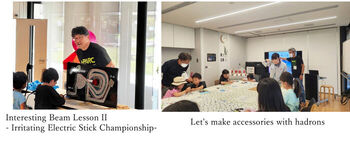 |
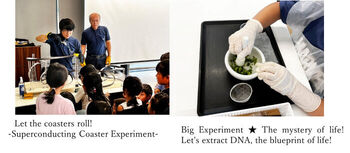 |
 |
 |
■Tokai Junior Ambassadors (elementary and junior high school students) visited J-PARC (September 14th)
Students visited J-PARC as part of the Tokai Junior Ambassador Training Dispatch Project.
■J-PARC Public Lecture (October 14th, , Mito City Civic Center )
To coincide with the J-PARC Symposium which runs from October 14th to 18th, a public lecture entitled “The future created by J-PARC, Exploring the mysteries - from Next-Generation Energy to Space -”will be held on October 14th (Monday, National Holiday) at the Mito City Civic Center.
Admission is free and no pre-registration is required. Please come along.
J-PARC Public Lecture Special Page
https://www.j-parc.jp/symposium/j-parc2024/
■J-PARC Sanpo-michi ㊿ Experimental Equipment Development Building Under Constructio
From the fourth floor of the J-PARC Research Building, where the Public Relations Section office is located, you can see the construction of the SOKENDAI Joint Research Center and the J-PARC Experimental Equipment Development Building ( J-PARC Development Building), which is currently under construction.
This building was selected and funded as part of the 'Project for the Development of Facilities for Industry-Academia-Government Collaboration and Joint Research through Collaboration between Regional Core Universities and Distinctive Research Universities', for which the Graduate University for Advanced Studies was the proposing university and KEK and other organizations were the collaborating organizations. As you can see in the photo, the foundations are currently being laid and the building is expected to be completed this fiscal year.
This will be the first major construction at J-PARC in exactly 10 years since the completion of the J-PARC Research Building in March 2015.
The vast J-PARC site is dotted with three accelerators and three experimental facilities, and it takes time to move between them.
The main feature of the J-PARC Development Building is that it has an open space of about 2,000 square meters.
This facility will be a base for the development of cutting-edge experimental equipment and research, as well as a base for collaboration between industry, academia, and the local community, bringing together people from different fields of research.


